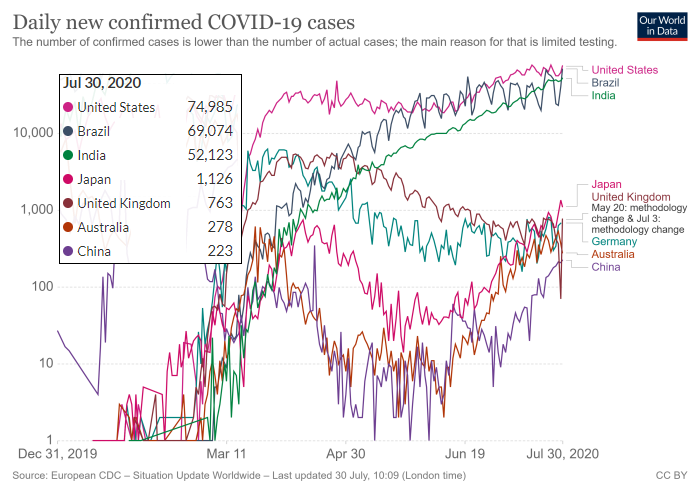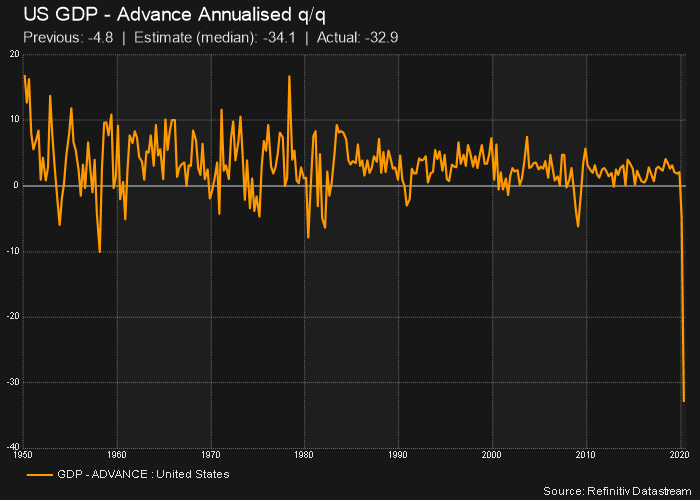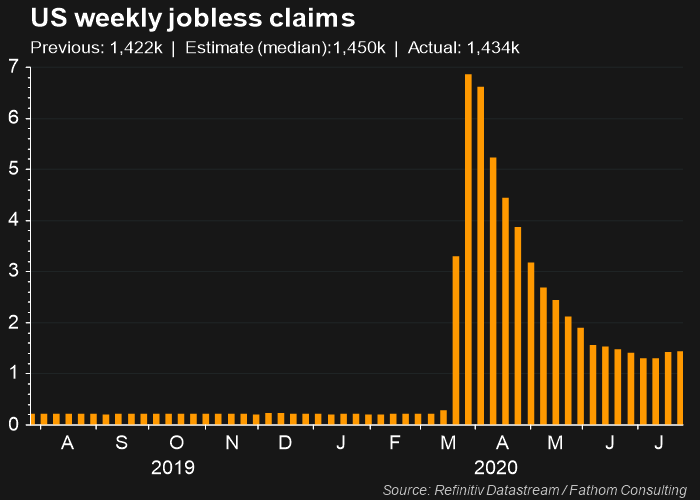A snapshot of overnight moves and a look to the upcoming Australasian session for 31 July.
Market Moves
Wrap
US markets were broadly lower Thursday, but closed well off their lows as earnings from major tech companies such as Apple, Amazon, Alphabet and Facebook each came in better than expected.
Early in the session, investors attempted to get their collective heads around the fact that the largest economy in the world likely shrunk by roughly one-third in the June quarter (see Macro Economy for more information).
The blue chip-laden Dow Jones Industrial Index pared early losses over 400 points to close down 225 points or 0.85%. The benchmark S&P500 ended with a narrow 0.38% loss, and the tech-heavy NASDAQ actually gained 0.43%.
Compounding the poor economic data early in the session, daily confirmed cases of covid-19, spiked once again to over 70k.

In general, risk on assets like stocks, metals and energy fell. Interestingly, so too did risk off assets like gold and silver. Bonds on the other hand, did manage to hold onto their gains by the end of the session.
Spot Gold is currently trading at US$1956/oz, whilst Silver is at trading US$23.42/oz.
Energy commodities were hardest hit as the market moved back into contango for the first time since April. This means that spot prices are lower than future prices on the basis of a building short term supply glut. West Texas Crude fell 2.05% to US$40.43/barrel, Brent fell 1.17%, and Natural was another 4.32%% lower.
In currency moves, Australian Dollar improved slightly to 0.7196, and is threatening to break out of its holding pattern beneath US$72c. The US Dollar Index declined 0.46%.
So with a clear risk off signal from overseas markets, albeit mitigated by the late rally in US stocks, where did the ASX200 Share Price Index end up? Well, it had a reasonably robust session, closing at 5986 compared to an overnight session high of 6005 and a low of 5908.
That's a 65 point discount to yesterday's ASX 200 close of 6051, and predictive of a 0.5-1.0% fall at the open for the S&P ASX200.
AU Companies
Early Broker Moves
Citigroup has lowered its price target for Sandfire Resources (SFR) from $5.60 to $5.40, raised its price target for Macquarie Group (MQG) from $110 to $125 and for Orocobre (ORE) from $3 to $3.90.
Jefferies raised its price target for MQG, from $138 to $148 and reiterated its "buy" rating.
Deutsche Bank raised its price target for Rio Tinto's (RIO) UK shares from 4900p to 5000p.
Trading Updates
Companies reporting trading updates to the market include: AMP Limited (AMP), Prospa Group (PGL) and Limeade (LME).
Macro Economy
Today, we'll see data on Australian wholesale prices in the form of the Produce Price Index (PPI), and also data on private sector credit. Both releases are slated for 9.30am EST.
Later tonight in the US, we'll see data on personal spending and incomes, the Chicago PMI, and the revised University of Michigan Consumer Sentiment Survey.
Below is a summary of the key macroeconomic data releases from the past 24 hours.
USA

The US economy shrank by nearly one-third in the June quarter. The stunning 32.9% annual rate of decline was the fastest contraction since World War 2. This is the first time ever the US economy has shrunk at a double digit pace in a single quarter. As bad as this result appeared, it was actually better than the 34.1% decline in growth most analysts were expecting.
Consumer spending, which is the main driver of the economy, contracted by a record 34.6% annual pace. Not surprisingly, travel and tourism were hardest hit, but there were also sharp falls in medical care and entertainment. Business investment saw a similar steep fall, and exports falling a whopping 64% also negatively impacting GDP.
Presently, economists are expecting GDP to bounce back at an 18% growth rate in the September quarter.

Americans filing for jobless benefits rose for the second straight week to 1.434m. This was slightly better than the 1.45m expected by economists.
Claims had been declining steadily since March, but as many states have been forced to roll back re-openings in the face of stubbornly high infection rates, businesses have curtailed hiring and instead shed more workers.